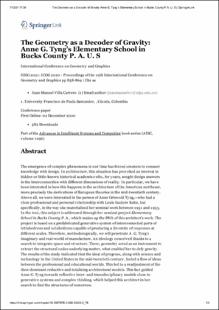The Geometry as a Decoder of Gravity: Anne G. Tyng’s Elementary School in Bucks County P. A. U. S
...
Villa Carrero, Juan Manuel | 2020-12-02
The emergence of complex phenomena in our time has forced creators to connect knowledge with design. In architecture, this situation has provoked an interest in hidden or little-known historical academics who, for years, sought design answers in the interconnection with different dimensions of reality. In particular, we have been interested in how this happens in the architecture of the American northeast, more precisely the derivations of European theories in the mid-twentieth century. Above all, we were interested in the person of Anne Griswold Tyng,—who had a close professional and personal relationship with Louis Isadore Kahn, but specifically, in the way she materialized her seminal work between 1951 and 1953. In the text, this subject is addressed through her seminal project Elementary School in Bucks County P. A., which makes up the DNA of this architect’s work. The project is based on a prefabricated generative system of interconnected parts of tetrahedrons and octahedrons capable of producing a diversity of responses at different scales. Therefore, methodologically, we will penetrate A. G. Tyng’s imaginary and real-world of manufacture. An ideology conceived thanks to a search to integrate space and structure. There, geometry acted as an instrument to extract the structural codes underlying matter, what enabled her to defy gravity. The results of the study indicated that the ideal of progress, along with science and technology in the United States in the mid-twentieth century, fueled a flow of ideas between the professional and educational worlds. This led to a readjustment of the then-dominant reductive and totalizing architectural models. This fact guided Anne G. Tyng towards reflective inter- and transdisciplinary models close to generative systems and complex thinking, which helped this architect in her search to find the structures of tomorrow
LEER











